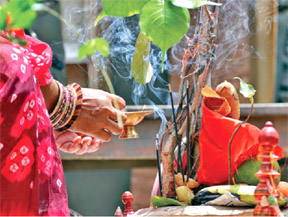 ‘Mata Bhumih, Putroaham Prithivyah’, such has been an integral bond with the Nature in our culture. Far from exploiting it, in Bharat the Nature has been adored and respected as much as the human beings
‘Mata Bhumih, Putroaham Prithivyah’, such has been an integral bond with the Nature in our culture. Far from exploiting it, in Bharat the Nature has been adored and respected as much as the human beings
Dr SP Shukla
The geographical entity, bounded by the mighty Himalayas in the North and the Hind Mahasagar in the South is known as Bharat, Hindustan or India. The inhabitants of this land are designated as Bharati (or Bharatiya), Hindus or Indians. Of these the term ‘Hindu’ is considered as the Iranian/ Persian adaptation of term’ Sindhu’. The term’ Sindhu’ denoting a river as well as region occurred first in the hymn of the Rigveda, perhaps the earliest text of the human race. The foundation of Indian culture and civilisation was laid during the Vedic era. All the subsequent developments in India, whether literary, philosophical, religious, moral or social derived inspiration from the Vedic literature and culture. The contribution of the Hindus in various fields of knowledge and thought has been admirable.
Their views on the importance of a sustainable environment and the existence of bio-diversity may provide solace to the strife-torn world which is facing worst climate crisis today.
The Vedic rishis and seers were highly knowledgeable persons who possessed a thorough understanding of material as well as spiritual domains. The Vedic mantras vividly speak about the pattern of their thinking. They always thought about the well-being of humanity. Their main concern was to realise the source of creation, the cause of vast and varied diversity.
They worshipped the forces of nature as various divinities but firmly thought that in essence these stood for One Being (ekam sat viprah bahudha vadanti—RV 1.164.46). The nature was accepted as divine manifestation. The Vedic seers considered various sources of water as pure and purifying. The Rigved (7.4.9.2), as translated by HH Wilson, informs: “May the waters that are in the sky, or those that flow (on the earth), those (whose channels) have been dug, or those that have sprung up spontaneously and seek the ocean, all be pure and purifying! May those divine waters protect me here (on earth)!”
Rivers flowing with sweet water are specially venerated and worshipped. The Saraswati River played an important role in the life of the Aryans. She was venerated as mother, river and goddess.
The ‘prithavi sukta’ of the Atharvaveda, consisting of sixty-three verses throws interesting light on the ecological consciousness of the Vedic people. In this text the physical details of the earth are affectionately mentioned with mountains, hills and deep forests are desired to bestow happiness, support all races and nations with their fertile, arable and nourishing qualities. The Mother earth is invoked to protect from her own anger, i.e. natural disasters and save from others’ exploitation and subjugation. The physical elements of earth, which included water, air and soil have great bearing on the prosperity of people which are extremely significant for the growth of agriculture, environmental sustenance and bio-diversity including plant life, animal world and human-beings. The Mother earth treats all as equal without discrimination of high or low. No one has an authority to harm or destroy the environment. All the species on this earth are equal. It is in this context, as explained in verse 18, the welfare of all and hatred towards none is emphasised. This injunction is of prime importance for the peaceful existence of different groups of people, races and nations. Sage Atharva, who visualised this significant ‘sukta’ was well aware of the existence of races of different people, following separate faiths and religions and speaking many languages. He has compared the Mother earth with Cosmic Cow, which gives us the thousand-fold prosperity without any hesitation, without being outraged by our destructive actions.
In the prayer people asked for the blessings of the mother earth to grant intellect and wisdom so that they may be able to speak in concord with heavenly beings, and continue to enjoy the blessings of hidden riches, glory, and realisation of material and spiritual well-being.
The epics and puranas also contain valuable insights regarding the environmental consciousness of their times. The great Mahabharata refers to the existence of many forests in India being the abode of famous sages and seers. In Kurukshetra itself, there were five forests as referred to in the Mahabharata and Vamana Purana. The Pandava heroes had taken shelter in the vana-parva of the Mahabharat. It is mentioned that if you want to protect forest, save lion, and if you want save lion, protect forest. It is a logical advice and practical as well. In the Bhagavad Gita, which is the most important part of the Mahabharata, while enumerating his manifestation (Vibhutis) he regarded Ganga among rivers and Asvattha/Peepal among the trees as his manifestations. The Peepal tree has been held as sacred right from the protohistoric times which can be seen painted on the earthen pots of the Early Saraswati-Sindhu Civilisation. In the Vedic-Harappan urban milieu the tradition continued, besides, this sacred tree came to be associated with divinities also. On a seal from Harappa a deity seated in meditation wears a Peepal twig on his head. Interestingly, Siddharth Gautam attained nirvana under the Peepal tree at Gaya and became the Buddha, the Enlightened One in sixth century BCE. This tree emits oxygen all the time which may have been useful in calming the mind. The Indians perhaps knew this phenomena since fairly early times. The Ayurveda also recognises the significance of its seeds, leaves and bark for medicinal value. Its wood was used in the yajnas. It was advised to protect and preserve this and other similar trees for the maintenance of environment and ecological balance. Sanskrit texts mention about the gardening in connection of town-planning. Rishi Parashara laid down the rules about trees to be planted in gardens, grafting and transplantation of trees as well as diseases of trees and their treatment (Bhatt, 527). The Krishiparashara, Vrishayurveda of king Surapala, Upavanavinoda etc. contain valuable information on this subject. In the opinion of Varahamihir, since tanks and the lakes do not look charming without shade on their sides, one ought to have garden laid out on the banks of water (Vrihat Samhita 55.1). Thus tanks and gardens are mutually beneficial.
Kautilya was the first thinker who framed rules against the person who caused an injury to a tree (Arthashastra 111.19). Even the throwing of the dirt on a public place was a punishable act. Besides, even throwing or causing latrine near a temple, well, or pond, sacred place or government building was a punishable act (Arthashastra 11.36).
Manusmriti (1V.56) also advised that one should not urinate or relieve himself or cough and throw impious objects in the water.
The Ayurvedic texts—Charaka Samhita, Sushruta Samhita, Ashtangahridaya etc. vividly speak about air and water pollution (vikriti). According to Charaka the polluted air with bad smell, oily, full of dirt, sand ‘stream creates’ diseases in the body. Likewise, the water, when it is excessively smelly, unnatural in colour, taste and touch which is not frequented by aquatic birds, is considered as polluted.
The concern of environment and protection of bio-diversity largely depends on the awareness of the people. In this connection the teachings of Jainism and Buddhism played a very important role in popularising the tenets of non-violence (ahimsa). The Jaina teachers showed great concern for dissemination of their ideas on co-existence based on non-violence.
Buddha laid great stress on the cultivation of ‘maitri’, ‘karuna’, ‘mudita’ and ‘upeksha’. Of these, ‘maitri’ (metta in Pali) referred to friendliness, goodwill and benevolence. King Ashoka, after the Kalinga war, devoted his energy in the spread of Dhamma (the eternal values of life) which laid emphasis on the welfare of all beings. He also prohibited the killing of animals and planted trees on the roadside. This all would have certainly enhanced the consciousness of the devotees in particular and people in general.
Let us always remember that earth is our Mother and we are her sons- ‘Mata Bhumih Putroaham Prthivyah’
(The writer is a historian and retired Professor from Kurukshetra University )














Comments